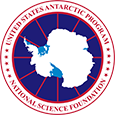Research Update: Baleen whale prey consumption based on high-resolution foraging measurementsPosted January 10, 2022
An estimated 1.5 million baleen whales that lived in the waters of the Southern Ocean were killed between 1910 and 1970. Now, a recent NSF-funded study showed a surprising result: along with the decline of baleen whales, was a decline of their predominant food source - krill. In a new study published in Nature, researchers used tagged whales with acoustic measurements of prey density to calculate the prey consumption of baleen whales. In the Southern Ocean, researchers calculate that pre-whaling populations of baleen whales annually consumed 430 million tons of Antarctic krill, twice the current estimated total biomass. Read more about the study on the NSF website and check out the Whale Engineers episode of The Discovery Files. |
Research Update: Baleen whale prey consumption based on high-resolution foraging measurements



For USAP Participants |
For The Public |
For Researchers and EducatorsContact UsU.S. National Science FoundationOffice of Polar Programs Geosciences Directorate 2415 Eisenhower Avenue, Suite W7100 Alexandria, VA 22314 Sign up for the NSF Office of Polar Programs newsletter and events. Feedback Form |

